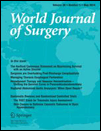Evaluation of Modified Estimation of Physiologic Ability and Surgical Stress in Patients Undergoing Surgery for Choledochocystolithiasis
Abstract
Background
The incidence of complicated choledochocystolithiasis is increasing with the aging of society in Japan. We evaluated the utility of our prediction rule modified estimation of physiologic ability and surgical stress (mE-PASS) in predicting postoperative adverse events in patients with choledochocystolithiasis.
Methods
A total of 4,329 patients who underwent elective surgery for choledochocystolithiasis in 44 referral hospitals between April 1987 and April 2007 were analyzed for mE-PASS along with postoperative events. The discrimination power of mE-PASS was assessed by the area under the receiver operating characteristic curve (AUC). The correlation between ordinal and interval variables was quantified by the Spearman rank correlation (ρ). The ratio of observed-to-estimated mortality rates (OE ratio) was used as a metric of surgical quality.
Results
Postoperative in-hospital mortality rates were 0 % (0/3,442) for laparoscopic cholecystectomy, 0.19 % (1/521) for open cholecystectomy, 1.6 % (1/63) for laparoscopic choledochotomy, 1.1 % (3/264) for open choledochotomy, and 5.1 % (2/39) for plasty or resection of the common bile duct. mE-PASS demonstrated a high discrimination power to predict in-hospital mortality; AUC, 95 % confidence interval (CI) of 0.96, 0.94–0.99. The predicted mortality rates significantly correlated with the severity of postoperative complications (ρ = 0.278, p < 0.0001) and length of hospital stay (ρ = 0.479, p < 0.0001). The OE ratios (95 % CI) improved slightly over time; 1.5 (0.25–9.0) between 1987 and 2000, and 0.40 (0.078–2.1) between 2001 and 2007.
Conclusions
The present study suggests that mE-PASS can predict postoperative risks in patients who have undergone choledochocystolithiasis. mE-PASS may be useful in surgical decision making and evaluating the quality of care.




